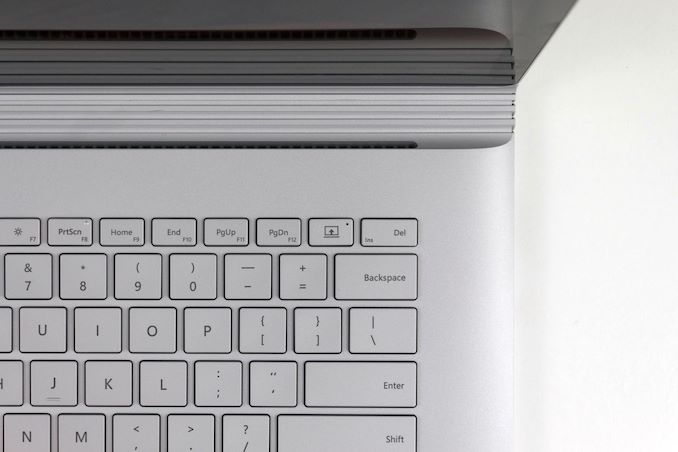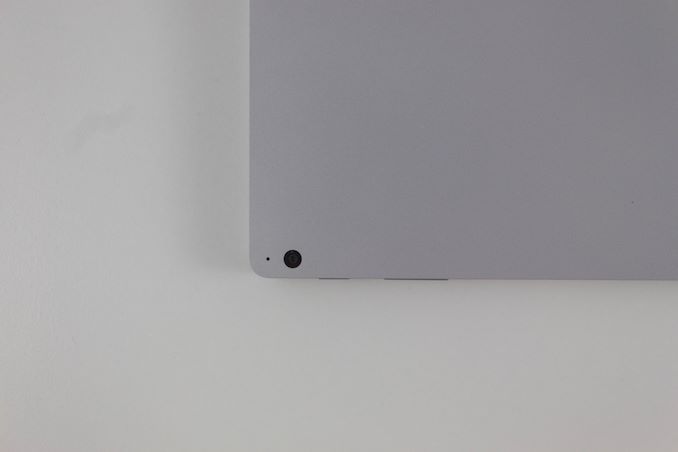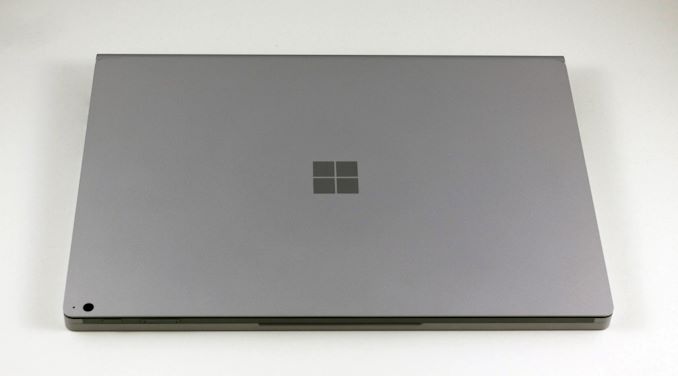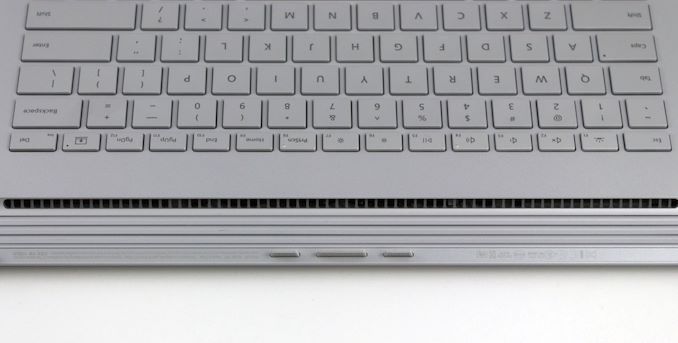The Microsoft Surface Book 3 (15-Inch) Review: A Refreshing Dip Into Ice Lake
by Brett Howse on June 3, 2020 9:00 AM ESTFinal Words
The Surface Book 3 delivers a solid refresh to Microsoft's detachable laptop family, offering more of almost everything. There is more performance thanks to the new Core i7-1065G7 and GeForce GTX 1660 Ti. There is more RAM thanks to the switch to LPDDR4X. The new 10 nm processor provides better battery life. The Wi-Fi is much improved thanks to the new Intel AX201 Wi-Fi 6 adapter. Even the USB ports got an upgrade to USB 3.2 Gen 2, while the Surface Connect port now offers the same 3.2 Gen 2 speeds along with DisplayPort 1.4 for dual-UHD external monitor support. If you loved the idea of the Surface Book 2 but thought it was a bit long in the tooth or otherwise underpowered, the new Surface Book 3 delivers all of the upgrades needed to keep it a proper current generation notebook.
Surface devices have always offered a great build quality, and the Surface Book 3 continues that legacy with its magnesium alloy chassis. Microsoft has improved the undocking mechanism to make it faster, and improvements to DirectX 12 mean that the system is finally able to automatically migrate active workloads from the discrete GPU to the integrated one when detaching, at least as long as the active application supports this.
The Surface Book 3, like the Surface Book 2, offers one of the best typing experiences on any notebook, and couples it with one of the best trackpads around. The display is still identical to the outgoing model, but that display is also one of the best available on a notebook, so it is hard to fault them for keeping it.
Microsoft still includes 1080p video recording support, with a 5 MP front facing camera and 8 MP rear facing camera, and coupled with the dual far-field microphones makes the Surface Book 3 an ideal, if somewhat overpowered, video conferencing device.
There is no denying that the upgrades have worked well. If there was a complaint, it would be that this is now the third generation of more or less the same design, and while a design that is still impressive, it also is showing its age. The large display bezels, while partially required due to the convertible nature of the Surface Book, stand out in a premium device in 2020. The lack of Thunderbolt 3 support is also an increasingly glaring omission when all of their competitors offer it. It took Microsoft a long time to adopt USB Type-C for reasons only they seem to understand, and while it is nice to finally have that, a universal docking solution over Thunderbolt 3 would serve them well.
The Surface Book 3 still does fulfill its role though as a very powerful laptop, built with premium materials, and offering some unique features. The upgrades for 2020 were necessary to keep the design relevant, even if is relatively unchanged on the outside. The new configuration options, especially the ability to purchase it with 32 GB of RAM, opens up the device to those who need a lot of RAM for their workflows, and being able to purchase it with Quadro RTX also opens the door to some new mobile workstation use cases. Surface Book is never going to be the sales leader in the Surface lineup, mostly due to the price, but there is no denying that it is still one of the best notebooks on the market.














125 Comments
View All Comments
Icehawk - Wednesday, June 3, 2020 - link
And don’t forget if they drain the battery you can’t plug them into a dock to turn it on, you need to use a standalone charger to get it up to 10% or so first. Ugh I am not a Surface fan AT ALL. I’ve supported almost all of the models.pjcamp - Wednesday, June 3, 2020 - link
I don't give a crap about bezels and I doubt anyone else does either, beyond tech pundits and reviewers who need something trendy to criticize. In fact, for devices to be held in the hands, like phones and tablets, bezels are a feature, not a bug, as they limit accidental activations.I own an original Surface Book, and I have a few observations about its durability.
In the end, the detachable form factor is not a good idea. It means if you want to get inside, you have to pry off the screen, a dicey proposition. It is fussy and fumbly to switch back and forth, which you really need to do if you need to change between drawing and typing as drawing in laptop mode is made quite difficult by the screen wobbling back and forth. It's best to think of this as a pure laptop.
The build quality is suspect. I've actually owned three of these things due to warranty replacements. Each of the previous ones had a power button that got stuck in the on position.
Also, I don't detach the screen very much, but the connection on all three computers became wonky. Suddenly it no longer sees the keyboard any more and announces that it is in tablet mode.
The memory wire attachment mechanism is clever, but it has gotten to the point that it doesn't work consistently. And the only recourse then is to find the one and only vent hole on the side that allows you to push a paper clip in at a 45 degree angle to force a manual release. That is clearly designed to prevent you from using it.
Batteries are not eternal but at this point my battery life with keyboard attached is down to less than two hours. That seems like an awfully quick degradation, as these things go.
The only thing that is an unmitigated good about these device, and it is a big thing, is the hi res 3:2 screen. If only Microsoft could make Windows scale appropriately instead of relying on each app to do it independently.
Spunjji - Thursday, June 4, 2020 - link
This pretty much summarises my understanding of the devices, from a support perspective... they're just fussy. Over-engineered would be another way of putting it. Impossible to repair, fragile, and generally not suited to regular use "in anger".A damn shame, really, as I like the concept.
Deicidium369 - Friday, June 5, 2020 - link
I am not sure about them being fragile - have had 10 or 11 deployed in the field, and they can at times take a beating - no failures in ~2 years - I have had my older model for going on 4, although doesn't get used that much anymore... still no issues.Spunjji - Friday, June 5, 2020 - link
Your ~11 beats my 2, but of those 2 both failed - and one had intermittent GPU driver issues even when it was working.amb9800 - Wednesday, June 3, 2020 - link
The GTX 1660 Ti Max-Q seems to be delivering better performance than expected (especially given it's a 65W part, vs. the 80W GTX 1060 Max-P in the Surface Book 2 15"), so it's not a completely worthless spec bump.That said, this would've been the perfect use case for the Ryzen 4000 U-series CPUs. Equipping the Surface Book 3 with a Ryzen 7 4800U would've allowed for performance on par with 45W 6/8-core Intel-based 15" competitors but within the Surface's 15-25W TDP budget.
Intel Ice Lake U-series is by far the biggest disappointment on this machine -- it (along with every other premium Intel-powered ultrabook) gets destroyed by the 4700U-powered $650 Acer Swift 3. The performance picture gets even worse when you look at, say, the Asus ROG Zephyrus G14, which ups the ante with the desktop-killing Ryzen 9 4900HS for under $1,500 -- with a 14" screen, solid battery life, and lower weight than even the 13" Surface Book 3.
lmcd - Thursday, June 4, 2020 - link
It's completely idiotic to compare a part that fits in a tablet form factor with a laptop sporting a 35W CPU. Whether the form factor is dumb or not is a different question.Worth remembering that Intel has delivered a "true SoC" platform for quite some time now. AMD's past CPUs, by comparison, weren't "true SoC" platforms and weren't even candidates to fit on this size of board. Ryzen 2x00U had an idle power bug across the platform, further removing it from candidacy.
That means the first AMD SoC the Surface Book team might've had the chance to integrate is the 3x00U. Based on how long it took for MS to integrate Ice Lake, the Surface Book 3 wouldn't get the 4700U until Christmas or later. Possibly longer considering that the 4700U is a more substantial change than Ice Lake vs past Intel SoCs.
lmcd - Thursday, June 4, 2020 - link
Yea just found this from the Renoir intro:"AMD’s latest Ryzen mobile product is the first design the company has done that combines CPU, GPU, and IO all on a monolithic die in TSMC’s 7nm process."
Indicating that IO wasn't entirely on-board before. Surface Book 4 could theoretically have a Ryzen design.
Deicidium369 - Friday, June 5, 2020 - link
Would imagine that the 1 AMD design they have would be sporting the 4000 series - wonder how much of a new design was needed to support it. Thermals would be better on the 4000 vs the older designSpunjji - Friday, June 5, 2020 - link
I think you've misinterpreted that - Renoir is the first AMD SoC that combines all of that *on 7nm*. I'm fairly sure Raven ridge included USB, SATA etc on-die - that's how the A300 Promontory "chipset" in the ASRock A300 does its thing.Wouldn't surprise me if the SoC had a larger package area than the Intel competitors, though. Intel have been working hard on that aspect for a few generations now.